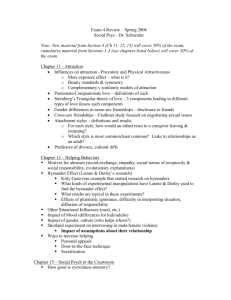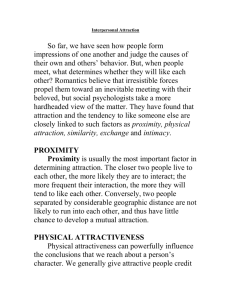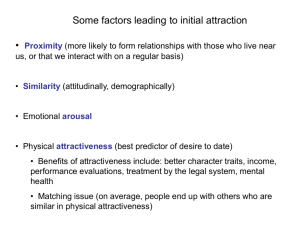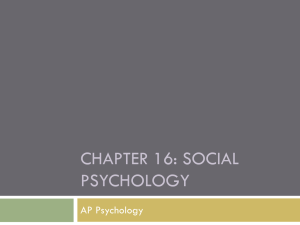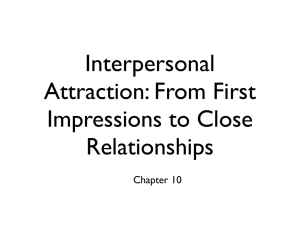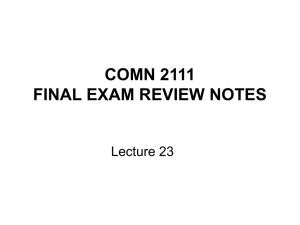Social Psychology (8–10%)
advertisement
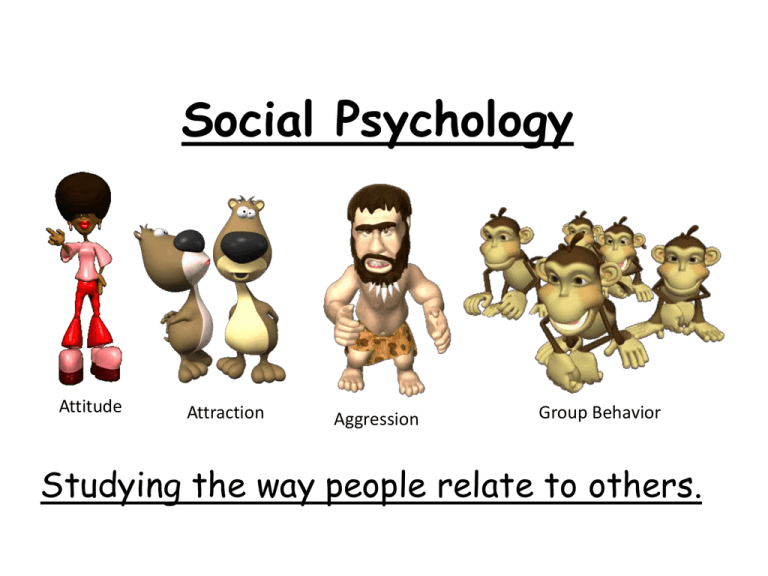
Social Psychology Attitude Attraction Aggression Group Behavior Studying the way people relate to others. AP EXAM: Social Psychology (8–10%) AP students in psychology should be able to do the following: • • • • • • • • • • • Apply attribution theory to explain motives (e.g., fundamental attribution error, self-serving bias). Describe the structure and function of different kinds of group behavior (e.g. deindividuation, group polarization). Explain how individuals respond to expectations of others, including groupthink,conformity, and obedience to authority. Discuss attitudes and how they change (e.g., central route to persuasion). Predict the impact of the presence of others on individual behavior (e.g.,bystander effect, social facilitation). Describe processes that contribute to differential treatment of group members (e.g., ingroup/out-group dynamics, ethnocentrism, prejudice). Articulate the impact of social and cultural categories (e.g., gender, race, ethnicity) on selfconcept and relations with others. Anticipate the impact of behavior on a self-fulfilling prophecy. Describe the variables that contribute to altruism, aggression, and attraction. Discuss attitude formation and change, including persuasion strategies and cognitive dissonance. Identify important figures in social psychology (e.g., Solomon Asch, Leon Festinger, Stanley Milgram, Philip Zimbardo). Attitudes • A set of beliefs and feelings. • Advertising is ALL based on attitude formation. • Mere Exposure Effect – the more you are exposed the more you will like it • Central Route T.P. v. Peripheral RouteT.P. Attitude and Behavior You have a belief that cheating on tests is bad. But you cheat on a test!!! • Do attitudes tell us about someone’s behavior? • LaPiere’s Study w/ Asian family showed attitudes don’t predict behavior Cognitive Dissonance Theory • People want to have consistent attitudes and behaviors….when they are not they experience The teacher was dissonance (unpleasant really bad so in that class it is OK. tension). • Usually they will change their attitude. • Never consciously aware of change in attitude Festinger & Carlsmith’s Cognitive Dissonance Experiment • Study participants completed a boring task and were then were paid to lie and tell the next subject that it was an enjoyable task. • Some subjects were paid $20, while others were paid $1. • Those who were paid less were found to have significantly more positive attitudes toward the experiment. Social Thinking Cognitive dissonance Compliance Strategies • People try to change other’s behavior (since that can then change attitudes) • Let’s imagine you want a trip to New York for graduation • Foot-in-the-door – first get a small “yes” to get bigger “yes” later • Door-in-the-face- get big “no” in order to get smaller “yes” • Norms of reciprocity – do something nice and then will have to say “yes” • Charities will often send a “free gift” when they send you a donation catalogue Compliance Strategies Reading Summarize the research on each of the following in one paragraph each: --Reciprocal Principle -- Foot in the door principle --Door in the face principle Each paragraph MUST HAVE: --Clear thesis sentence -- 2 citations of research Attribution Theory • Tries to explain how people determine the cause of the behavior they observe. It is either a…. • Situational Attribution- behavior is product of environment • Dispositional Attributionbehavior is product of personality And • Stable Attribution • Unstable Attribution Fundamental Attribution Error • We tend to overestimate the role You probably of dispositional attribute it to their personality rather factors in the than their profession. behavior of other. But do you really Individualistic V. know? Collectivistic Cultures We assume that our own False Consensus Effect beliefs are the “norm” and others think like us. Self-Serving Bias How do you view your teacher’s behavior? When we do something good its because of us, and when we do something bad, its someone else’s fault. False Consensus Effect We tend to overestimate the extent in which others share our beliefs and behaviors. Self-Serving Bias If you win it is because you are awesome…if you lose, it must have been the referees or weather or…. Stereotypes, Prejudice and Discrimination Stereotype: • Overgeneralized idea about a group of people. Prejudice: • Undeserved (usually negative) attitude towards a group of people. Ethnocentrism is an example of a prejudice. Discrimination: • An action based on a idea of prejudice. Does perception change with race? Does race change how we perceive? Mr. Dycus, Remember to prove to the students that racism is still alive by showing them that pretty awesome power point you made a few years ago for Contemporary Issues. Thanks. Is it just race? NO • Palestinians and Jews • Dub-V Nation vs inferior neighboring schools • Men and Women But women have some things going for them like…… Which person would you want to have a long term relationship with? How does prejudice occur? “Just world” Phenomenon -people get what they deserve (using Fundamental Attribution Error) • In one popular study female and male subjects were told two versions of a story about an interaction between a woman and a man. Both variations were exactly the same, except at the very end the man raped the woman in one and in the other he proposed marriage. • In both conditions, both female and male subjects viewed the woman's (identical) actions as inevitably leading to the (very different) results. In-Group versus Out-Groups. • In-Group Bias– experiment with abstract art groups and then $2/$1, or $4/$3 • Out-Group Homogeniality—assumption that all “out group” members share the same traits (stereotyping) - Information on “out-groups” that we don’t live with are media (negatively) driven Scapegoat Theory- people suffering need someone to blame Combating Prejudice Contact Theory • Contact between hostile groups will reduce animosity if they are made to work towards a superordinate goal—a goal deemed more important than differences • Education about race? • Obama’s election as an example of Prejudices can often lead to a…. Self-Fulfilling Prophecy • A prediction that causes itself to be true. • Rosenthal and Jacobson’s “Pygmalion in the Classroom” experiment. • Pygmalion effect Psychology of Aggression Two types of aggression 1. Instrumental Aggression– with a purpose 2. Hostile Aggression- no clear purpose Theories of Aggression: 1.Bandura’s Bobo Doll Modeling – social learning thoery that humans learn aggression as children 2. Frustration-Aggression Hypothesis- inherited response to stress 3. Institutional Aggression Hot Weather and Aggression Bandura Bobo Doll Read and Respond Write a three paragraph response with each of the following paragraphs doing this: Paragraph 1: Describe the study itself including one citation of evidence. Paragraph 2: Describe the results and how they can be applied to life using one citation of the evidence. Paragraph 3: Summarize the critique of Bandura’s experiment using one citation of the evidence. Prosocial Behavior • Kitty Genovese case in Kew Gardens NY. Bystander Effect: • Conditions in which people are more or less likely to help one another. In general…the more people around…the less chance of help….because of… • Diffusion of Responsibility– more people means responsibility is divided • Pluralistic Ignorance People decide what to do by looking to others. Factors that Influence Helping: • • • • • • • • Situational ambiguity Perceived Cost Diffusion of Responsibility Similarity Mood Gender Attributions of the cause of need Social Norms Attraction 5 Factors of Attraction Quotes "Life has taught us that love does not consist in gazing at each other but in looking outward together in the same direction." --- Antoine de Saint-Exupery It is with true love as it is with ghosts; everyone talks about it, but few have seen it. --La Rochefoucauld "When two people are under the influence of the most violent, most insane, most delusive, and most transient of passions, they are required to swear that they will remain in that excited, abnormal, and exhausting condition continuously until death do them part.“ --George Bernard Shaw Ideal Qualities in a Romantic Partner 1 2 3 Less than me About the same as me More than me 1 Extraversion 2 Conscientiousness 3 Agreeableness 4 Openness 5 Neuroticism 6 Age 7 Height 8 Education 9 Intelligence 10 Good Looks 11 Social Status 12 Spirituality 13 Dominance 30 Preferred Qualities in Partners Women 1) Kind/understanding 2) Exciting Personality 3) Intelligent 4) Healthy 5) Easy Going 6) Physically Attractive Men Kind/understanding Exciting Personality Intelligent Physically Attractive Healthy Easy Going 31 1. Proximity • Geographic nearness • Mere exposure effect: Repeated exposure to something breeds liking. • Classroom studies – Moreland & Beach (1992): women coming into class; the more they came to class, the more other students liked her • 4 women in study • Forced proximity = stalking (which isn’t attractive) Proximity Mere exposure (Zajonc, 1966; Moreland & Beach 1992) 4.6 4.4 4.2 Ratings of attraction. 4 3.8 3.6 3.4 3.2 3 0 5 10 15 Which version do you prefer? A B 2. Reciprocal Liking • You are more likely to like someone who likes you. • Why? • People like positive feedback • Even obvious attempts at flattery increase liking • Playing TOO hard to get is viewed as a turn off • Except in elementary school!!!! • “Couples curse” of decreasing affinity 3. Similarity • Paula Abdul was wrong- opposites do NOT attract. • Birds of the same feather do flock together. • Similarity breeds content. Similarily • • • • Together SAT .31* Phy Attr .32* Attitudes .50* • • • • Breakup SAT .17 Phy Attr .16 Attitudes .41* Role of the Internet in Dating Role of the Internet in Dating Attitude similarity and attraction Attraction toward other person (range = 2-14) Byrne and Nelson (1965) asked to rate how much they liked a stranger after learning he agreed with varying proportions of their attitudes expressed on a questionnaire. (Higher numbers indication greater liking.) 13.00 12.00 11.00 10.00 9.00 As the graph shows, the greater the proportion of attitudes subjects shared with the stranger, the more subjects liked him 8.00 7.00 6.00 .00 .20 .40 .60 .80 1.00 Proportion of similar attitudes held by other person Similarity • What traits did you want to match your partner on? Similarity – Couples tend to be similar in age, race, religion, social class, personality, education, intelligence, physical attractiveness, and attitudes – Personality similarity related to marital happiness. – Perceived similarity more strongly associated with marital satisfaction than actual similarity 42 What personality traits are important to match on? • Connection between personality traits and relationship satisfaction. • Low neuroticism. A partner higher in neuroticism might be more critical, contemptuous and defensive with their partner decreasing satisfaction. • Higher agreeableness, conscientiousness and extraversion. • Matching on Individual Big 5 traits does not predict satisfaction but matching on overall profile does. 43 Similarity Matching Hypothesis: We like those who are like ourselves (Galton, 1870). Romantic pairs are similar in physical attractiveness (Zajonc et al, 1987) Even college roommates, prefer to be of similar attractiveness (Carlie et al. 1991) Sense of humor particularly important (Cann et al., 1995) Similarity • Why do we like people like us? • Why does similarity increase relationship satisfaction? 45 Mimicry-Similarity in Behavior • When we want to belong to a group or want others to like us, we mimic their behavior. • We like people who mimic our behavior. • But don’t be too obvious!!! 46 Mimicry: Similarity in Behavior Behavioral Mimicry 47 People get more similar over time • Dissimilar looking couples at marriage look more similar 25 years later. • Happier couple look more similar • Decades of shared emotions? – Facial expression “save” micro muscles into our older face. 48 Similarity to Pets 49 4. Liking through Association • Classical Conditioning can play a part in attraction. • I was always attracted to girls wearing UGA snap backs… • Misattribution of arousal • Negative mood leads to lower attractiveness ratings • Unpleasant background music when meeting a person leads to subsequent lower attractiveness ratings Misattribution of Arousal 5. Physical Attractiveness Who do you think is friendlier? Who do you think is more outgoing? To whom would you be friendlier? The Hotty Factor – Halo Effect -- “What Is Beautiful Is Good” stereotype – People tend to attribute desirable characteristics such as sociable, friendly, poised, warm, competent, and well adjusted to those who are good looking – Physically attractiveness predicts dating frequency (they date more). – Attractive children and adults are judged and treated more favorably – Implications for career & salary – Criminal sentences… 54 What is beauty? Physical Attraction Beauty is objective: 1) High level of agreement across cultures (Langlois et al, 2000) 2) Certain features of faces are reliably associated with attractiveness (Cunningham, 1986) 3) Babies prefer attractive faces (Cowley, 1996). Physical Attraction Beauty is subjective: 1) Different cultures “improve” beauty in different ways (Newman, 2000). 2) Different body types are judged to be more attractive in different parts of the world (Anderson et. al 1992) 3) Body type standards vary over time (Silverstein et al, 1986). Physical Attraction Things that people agree on: 2) More average faces are more attractive 3) Waist/hip ratio for women is judged similarly across culture. Men prefer waists 1/3 narrower than hips (Singh, 1993) 4) Across culture, women prefer men to have a V-shaped physique (Singh, 1995) Physical Attraction Things that people agree on: 5) Women who have large eyes, prominent cheekbones, small bones and a wide smile are judged more attractive (Cunningham, 1986) 6) Men with broad jaws and chiseled features are judged more attractive (Cunningham et al, 1990). Physical Attraction Situational influences on attraction: 1) Contrast effects (Kenrick et al, 1993) 2) Opinions of same sex peers (for women) (Graziano et al, 1993) 3) Girls all get prettier at closing time effect, (Gladue & Delaney, 1990) 4) Glasses (Terry & Macy, 1991) Physical Attraction Good male names: Alexander, Joshua, Mark, Henry, Scott, Taylor, Jonathan Blake Dycus Good female names: Elizabeth, Mary, Jessica, Ann, Brittany, Isabella Bad male names: Otis, Roscoe, Norbert, Ogden, Willard, Eugene Bad female names: Mildred, Frieda, Agatha, Harriet, Rosalyn, Tracy Beauty and Culture Obesity is so revered among Mauritania's white Moor Arab population that the young girls are sometimes force-fed to obtain a weight the government has described as "life-threatening". Are these cultures really that different? Courtship 1) Opening Lines 2) Female Courtship Rituals 3) Male Courtship Rituals Introductions Kleinke et al, 1990; Cunningham, 1989 Looked at the effectiveness of different types of opening lines in laboratory, and then real life settings Likeability 6.6 6.4 6.2 6 5.8 5.6 5.4 5.2 5 Flippant Innocuous Direct Introductions Kleinke et al, 1990; Cunningham, 1989 Setting Best Line Worst Line Bar Do you want to dance? Bet I can out-drink you! Laundromat Want to have a cup of coffee while we’re waiting Beach Want to play frisbee? Those are some nice undies you have there Let me see your strap marks. Female Courtship Rituals Women’s flirting behavior Eibl-Eibesfeldt (1989): 1) Smile 2) Lift Eyebrows in fast jerky motion 3) Open their eyes wide 4) Lower their eyelids 5) Tilt heads down and to the side 6) Look away Female Courtship Rituals Moore (1985; 1989): Female courtship behaviors were defined as that specific subset of nonverbal behavior that consistently resulted in male attention 52 items identified Courtship found to be more important that physical attraction for garnering male interest. Male Courtship Rituals Male courtship rituals: Submissive displays: Palms up, shoulder shrug, tilt head. Dominance displays: Entering personal space, putting arm around shoulder, swagger. Resources displays: Paying for food, drink. Wearing expensive clothes. Bragging. Male Courtship Rituals Male rituals harder to chronicle (Taflinger, 1996): The less ritualized and more original his approach is, the more likely a woman is to accept it This leads to ad hoc courtship by human males. Love Passionate Love • My stomach feels weird, I want to be with you all the time, I can’t stop thinking of you kind of love. • DOES NOT LAST FOREVER. Compassionate Love • Love that comes from people living shared lives together and depend on one another for love and support. • Can last forever…or cannot • Can include passionate love • Includes self disclosure Marital Satisfaction over Time Ratings of marital quality In a longitudinal study that spanned ten years, married couples rated the quality of their marriages. On average, these ratings were high, but they declined among both husbands and wives. As you can see, there were two steep drops, occurring during the first and eighth years of marriage. (Kurdek, 1999.) 1 2 3 4 5 6 7 Years of marriage Wife Husband 8 9 10 Changes in Life Satisfaction Before and After Divorce In this study, 817 men and women who were divorced at some point rated how satisfied they were with life on a scale of 0 to 10 every year for eighteen years. Overall, divorcees were less satisfied than their married counterparts-a common result. On the question of whether time heals the wound, you can see that satisfaction levels dipped before divorce, rebounded afterward, but did not return to original levels. It appears that people adapt but do not fully recover from this experience. (Lucas, 2005.) Life Satisfaction Ratings 0.00 -0.50 Divorce -1.00 -8 -6 -4 -2 0 2 Years Before and After Divorce 4 6 Liking & Loving for Dating Partners and Same-Sex Friends Index Women Men Love for Partner 89.5 89.3 Liking for Partner 88.7 84.6 Love for Friend 65.3 55.1 Liking for Friend 80.5 79.1 “No man or woman really knows what love is until they have been married a quarter of a century.” --- Mark Twain Love marriages Satisfaction Arranged marriages 90 80 70 60 50 40 0-1 1-2 2-5 5-10 Years of marriage 10+ Relationship Conflict --- Some Issues • Jealousy --- Men Sexual infidelity (60%) Women Emotional infidelity (83%) • Communication --Demand-withdraw interaction pattern (Females wish to discuss problems, men avoid/withdraw from such discussions) • Sex • Children • Money • Different expectations What predicts stability? • When is divorce less likely? – First or second marriage? – Older or younger at marriage? – More or less educated partners? – Stable or unstable jobs? – Cohabitation or non-cohabitation? – Parental divorce or no parental divorce? Group Behavior How do groups affect our behavior? Social Facilitation Theory • If you are really good at something….or it is an easy task…you will perform BETTER in front of a group. • If it is a difficult task or you are not very good at it…you will perform WORSE in front of a group (social impairment). Conformity Studies • Adjusting one’s behavior or thinking to coincide with a group standard. Asch’s Study of Conformity Asch’s Results • About 1/3 of the participants conformed. • 70% conformed at least once. To strengthen conformity: • • • • The group is unanimous The group is at least three people. One admires the group’s status One had made no prior commitment Social Influence 50% Difficult judgments 40 Percentage of conformity to confederates’ wrong answers Conformity highest on important judgments 30 20 10 Easy judgments 0 Low High Importance Participants judged which person in Slide 2 was the same as the person in Slide 1 Reasons for Conforming Khan Academy Normative Social Influence: Informational Social Influence: Influence resulting from a person’s desire to gain approval or avoid disappointment Influence resulting from one’s willingness to accept others’ opinions about reality Would how you dress for school be affected, if you lived in small-town Texas? • When could this be an example of normative social influence? • When could this be an example of informative social influence? Milgram’s Study Of Obedience Experimenter Prompts: 1. 2. 3. 4. Please continue (or Please go on). The experiment requires that you continue. It is absolutely essential that you continue. You have no other choice, you must go on. Results of the Milgram Study What did we learn from Milgram? • Ordinary people can do shocking things. • Ethical issues…. • Would not have received approval from today’s IRB (Internal Review Board). Group Dynamics Situational Influence Home Advantage in Major Team Sports Sport Games Studied Home Team Winning Percentage Baseball 23,034 53.3% Football 2,592 57.3 Ice hockey 4,322 61.1 Basketball 13,596 64.4 Soccer 37,202 69.0 Social Loafing • The tendency for people in a group to exert less effort when pooling efforts toward a common goal than if they were individually accountable. • One of the reasons I hate group work… Group Polarization • Groups tend to make more extreme decisions than the individual. Groupthink • Group members suppress their reservations about the ideas supported by the group. • They are more concerned with group harmony. • Worse in highly cohesive groups. Deindividuation • People get swept up in a group and lose sense of self. • Feel anonymous and aroused. • Explains rioting behaviors. Zimbardo’s Prison Study • Showed how we deindividualize AND become the roles we are given. • Philip Zimbardo has students at Stanford U play the roles of prisoner and prison guards in the basement of psychology building. • They were given uniforms and numbers for each prisoner. • What do you think happened? Institutional Aggression and Zimbardo’s Stanford Prison Study 1. Explain the study in one paragraph using both the “Pathological prisoner syndrome” and “Pathology of power”. 2. Why didn’t the “good guards” say anything to the “bad guards”? 3. Describe what happened at Abu Ghraib. 4. What situational factors were at play that led the US military people to act like they did? 5. Can “cause and effect” ever TRULY be found in these complicaticated cases of “institutional aggression? Social Relations Conflict perceived incompatibility of actions, goals, or ideas Social Trap or Prisoner’s Dilemma Axelrod & Hamilton (1981) a situation in which the conflicting parties, by each rationally pursuing their self-interest, become caught in mutually destructive behavior Video: http://www.youtube.com/watch?v=ED9gaAb2BEw
